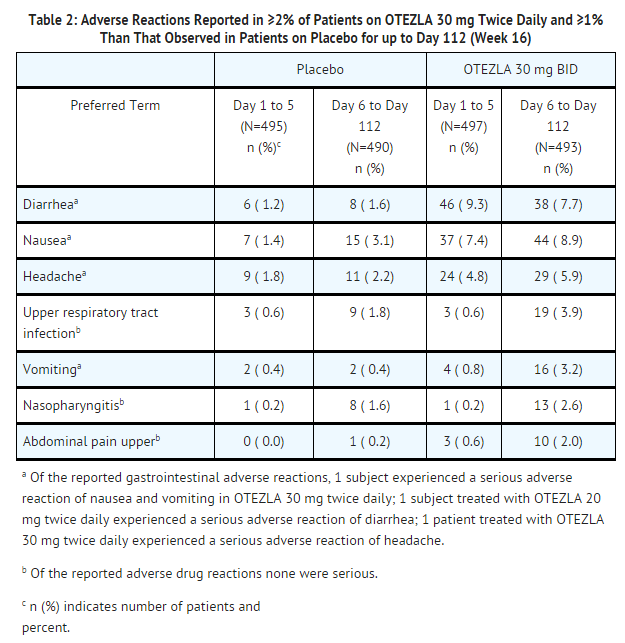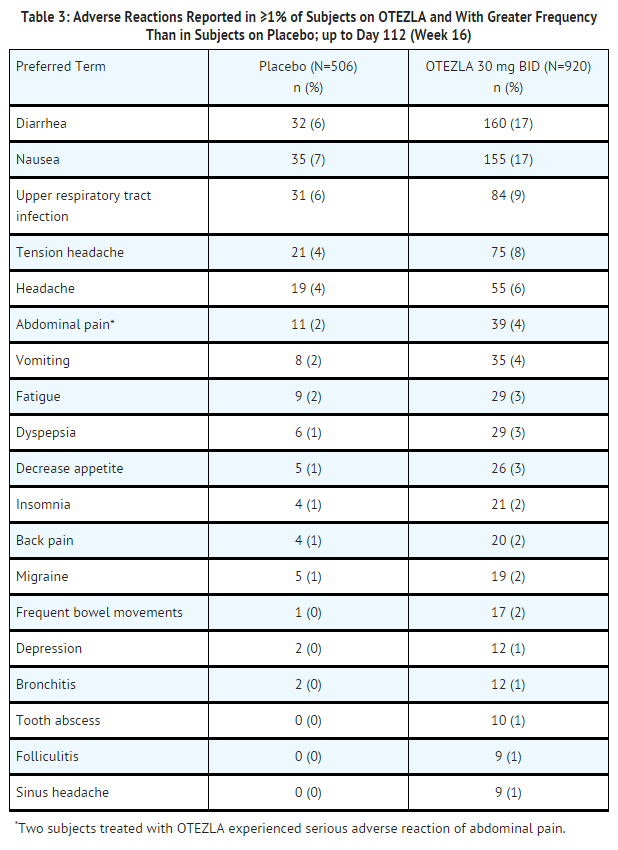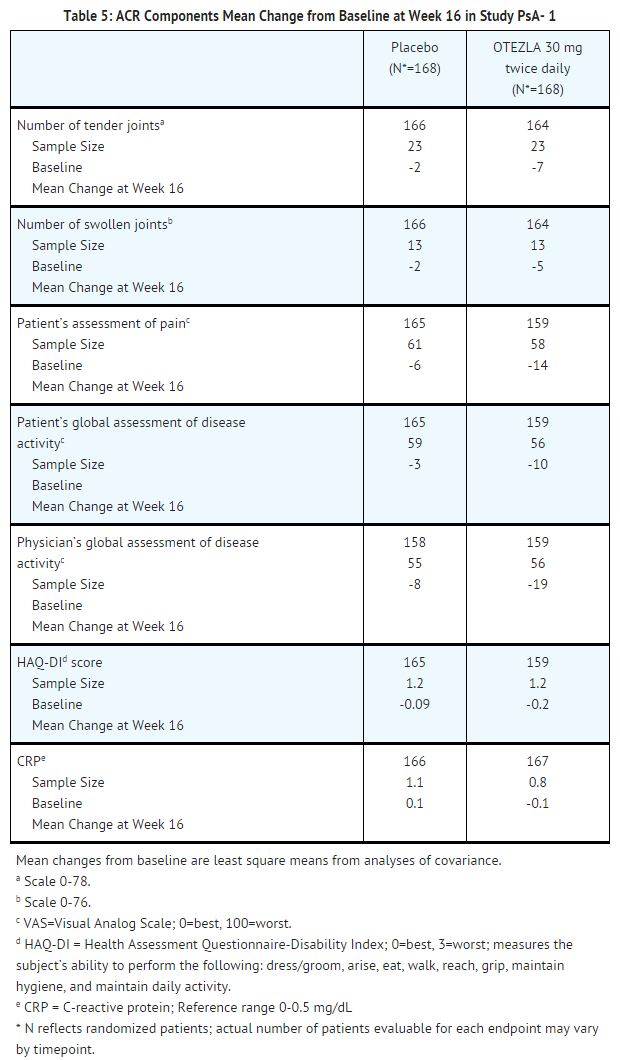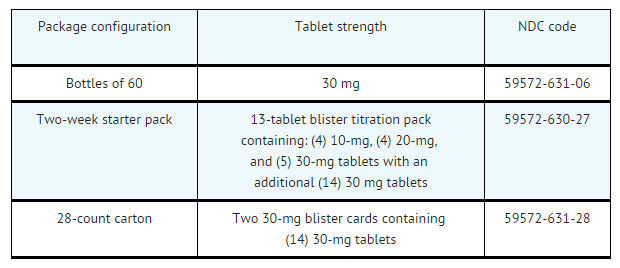Apremilast
{{DrugProjectFormSinglePage |authorTag=Rabin Bista, M.B.B.S. [1] |genericName=Apremilast |aOrAn=a |drugClass=Phosphodiesterase Inhibitor |indicationType=treatment |indication=active psoriatic arthritis, moderate to severe plaque psoriasis who are candidates for phototherapy or systemic therapy |adverseReactions=diarrhea, nausea, and headache
|blackBoxWarningTitle=ConditionName:
|blackBoxWarningBody=ConditionName:
|fdaLIADAdult=====Indications====
Psoriatic Arthritis
- OTEZLA is indicated for the treatment of adult patients with active psoriatic arthritis.
Psoriasis
- OTEZLA is indicated for the treatment of patients with moderate to severe plaque psoriasis who are candidates for phototherapy or systemic therapy.
Dosage
Dosage in Psoriatic Arthritis and Psoriasis
- The recommended initial dosage titration of OTEZLA from Day 1 to Day 5 is shown in TABLE 1. Following the 5-day titration, the recommended maintenance dosage is 30 mg twice daily taken orally starting on Day 6. This titration is intended to reduce the gastrointestinal symptoms associated with initial therapy.
- OTEZLA can be administered without regard to meals. Do not crush, split, or chew the tablets.
Dosage Adjustment in Patients With Severe Renal Impairment
- OTEZLA dosage should be reduced to 30 mg once daily in patients with severe renal impairment (creatinine clearance (CLcr) of less than 30 mL per minute estimated by the Cockcroft–Gault equation). For initial dosage titration in this group, it is recommended that OTEZLA be titrated using only the AM schedule listed in TABLE 1 and the PM doses be skipped.
DOSAGE FORMS AND STRENGTHS
- OTEZLA is available as diamond shaped, film coated tablets in the following dosage strengths:
- 10-mg pink tablet engraved with “APR” on one side and “10” on the other side
- 20-mg brown tablet engraved with “APR” on one side and “20” on the other side
- 30-mg beige tablet engraved with “APR” on one side and “30” on the other side.
|offLabelAdultGuideSupport=There is limited information regarding Off-Label Guideline-Supported Use of Apremilast in adult patients.
|offLabelAdultNoGuideSupport=There is limited information regarding Off-Label Non–Guideline-Supported Use of Apremilast in adult patients.
|fdaLIADPed=There is limited information regarding FDA-Labeled Use of Apremilast in pediatric patients.
|offLabelPedGuideSupport=There is limited information regarding Off-Label Guideline-Supported Use of Apremilast in pediatric patients.
|offLabelPedNoGuideSupport=There is limited information regarding Off-Label Non–Guideline-Supported Use of Apremilast in pediatric patients.
|contraindications=* OTEZLA is contraindicated in patients with a known hypersensitivity to apremilast or to any of the excipients in the formulation
|warnings======Depression=====
- Treatment with OTEZLA is associated with an increase in adverse reactions of depression. Before using OTEZLA in patients with a history of depression and/or suicidal thoughts or behavior prescribers should carefully weigh the risks and benefits of treatment with OTEZLA in such patients. Patients, their caregivers, and families should be advised of the need to be alert for the emergence or worsening of depression, suicidal thoughts or other mood changes, and if such changes occur to contact their healthcare provider. Prescribers should carefully evaluate the risks and benefits of continuing treatment with OTEZLA if such events occur.
Psoriatic arthritis
- During the 0 to 16 week placebo-controlled period of the 3 controlled clinical trials, 1.0% (10/998) of subjects treated with OTEZLA reported depression or depressed mood compared to 0.8% (4/495) treated with placebo. During the clinical trials, 0.3% (4/1441) of subjects treated with OTEZLA discontinued treatment due to depression or depressed mood compared with none in placebo treated subjects (0/495). Depression was reported as serious in 0.2% (3/1441) of subjects exposed to OTEZLA, compared to none in placebo-treated subjects (0/495). Instances of suicidal ideation and behavior have been observed in 0.2% (3/1441) of subjects while receiving OTEZLA, compared to none in placebo treated subjects (0/495). In the clinical trials, 2 subjects who received placebo committed suicide compared to none in OTEZLA-treated subjects.
Psoriasis
- During the 0 to 16 week placebo-controlled period of the 3 controlled clinical trials, 1.3% (12/920) of subjects treated with OTEZLA reported depression compared to 0.4% (2/506) treated with placebo. During the clinical trials, 0.1% (1/1308) of subjects treated with OTEZLA discontinued treatment due to depression compared with none in placebo-treated subjects(0/506). Depression was reported as serious in 0.1% (1/1308) of subjects exposed to OTEZLA, compared to none in placebo-treated subjects (0/506). Instances of suicidal behavior have been observed in 0.1% (1/1308) of subjects while receiving OTEZLA, compared to 0.2% (1/506) in placebo-treated subjects. In the clinical trials, one subject treated with OTEZLA attempted suicide while one who received placebo committed suicide.
Weight Decrease
- During the controlled period of the studies in psoriatic arthritis (PsA), weight decrease between 5%-10% of body weight was reported in 10% (49/497) of subjects treated with OTEZLA 30 mg twice daily compared to 3.3% (16/495) treated with placebo.
- During the controlled period of the trials in psoriasis, weight decrease between 5%-10% of body weight occurred in 12% (96/784) of subjects treated with OTEZLA compared to 5% (19/382) treated with placebo. Weight decrease of ≥10% of body weight occurred in 2% (16/784) of subjects treated with OTEZLA 30 mg twice daily compared to 1% (3/382) subjects treated with placebo.
- Patients treated with OTEZLA should have their weight monitored regularly. If unexplained or clinically significant weight loss occurs, weight loss should be evaluated, and discontinuation of OTEZLA should be considered.
|clinicalTrials=====Clinical Trials Experience====
- Because clinical trials are conducted under widely varying conditions, adverse reaction rates observed in the clinical trial of a drug cannot be directly compared to rates in the clinical trials of another drug and may not reflect the rates observed in clinical practice.
Psoriatic Arthritis Clinical Trials
- OTEZLA was evaluated in 3 multicenter, randomized, double-blind, placebo-controlled trials [Studies PsA-1, PsA-2, and PsA-3] of similar design in adult patients with active psoriatic arthritis. Across the 3 studies, there were 1493 patients randomized equally to placebo, OTEZLA 20 mg twice daily or OTEZLA 30 mg twice daily. Titration was used over the first 5 days. Placebo patients whose tender and swollen joint counts had not improved by at least 20% were re-randomized 1:1 in a blinded fashion to either OTEZLA 20 mg twice daily or 30 mg twice daily at week 16 while OTEZLA patients remained on their initial treatment. Patients ranged in age from 18 to 83 years, with an overall median age of 51 years.
- The majority of the most common adverse reactions presented in TABLE 2 occurred within the first 2 weeks of treatment and tended to resolve over time with continued dosing. Diarrhea, headache, and nausea were the most commonly reported adverse reactions. The most common adverse reactions leading to discontinuation for patients taking OTEZLA were nausea (1.8%), diarrhea (1.8%), and headache (1.2%). The proportion of patients with psoriatic arthritis who discontinued treatment due to any adverse reaction was 4.6% for patients taking OTEZLA 30 mg twice daily and 1.2% for placebo-treated patients.
- Other adverse reactions reported in patients on OTEZLA in clinical studies including extension studies:
- Immune system disorders: Hypersensitivity
- Investigations: Weight decrease
- Gastrointestinal Disorders: Frequent bowel movement, gastroesophageal reflux disease, dyspepsia
- Metabolism and Nutrition Disorders: Decreased appetite
- Nervous System Disorders: Migraine
- Respiratory, Thoracic, and Mediastinal Disorders: Cough
- Skin and Subcutaneous Tissue Disorders: Rash
- 1 patient treated with OTEZLA 30 mg twice daily experienced a serious adverse reaction.
Psoriasis Clinical Trials
- The safety of OTEZLA® was assessed in 1426 subjects in 3 randomized, double-blind, placebo-controlled trials in adult subjects with moderate to severe plaque psoriasis who were candidates for phototherapy or systemic therapy. Subjects were randomized to receive OTEZLA 30 mg twice daily or placebo twice daily. Titration was used over the first 5 days. Subjects ranged in age from 18 to 83 years, with an overall median age of 46 years.
- Diarrhea, nausea, and upper respiratory tract infection were the most commonly reported adverse reactions. The most common adverse reactions leading to discontinuation for subjects taking OTEZLA were nausea (1.6%), diarrhea (1.0%), and headache (0.8%). The proportion of subjects with psoriasis who discontinued treatment due to any adverse reaction was 6.1% for subjects treated with OTEZLA 30 mg twice daily and 4.1% for placebo-treated subjects.
- Severe worsening of psoriasis (rebound) occurred in 0.3% (4/1184) subjects following discontinuation of treatment with OTEZLA.
|postmarketing=There is limited information regarding Postmarketing Experience of Apremilast in the drug label.
|drugInteractions======Strong CYP450 Inducers=====
- Apremilast exposure is decreased when OTEZLA is co-administered with strong CYP450 inducers (such as rifampin) and may result in loss of efficacy
- Co-administration of strong cytochrome P450 enzyme inducer, rifampin, resulted in a reduction of systemic exposure of apremilast, which may result in a loss of efficacy of OTEZLA. Therefore, the use of cytochrome P450 enzyme inducers (e.g., rifampin, phenobarbital, carbamazepine, phenytoin) with OTEZLA is not recommended
|FDAPregCat=C |useInPregnancyFDA======Pregnancy Exposure Registry=====
- There is a pregnancy exposure registry that monitors pregnancy outcomes in women exposed to OTEZLA during pregnancy. Information about the registry can be obtained by calling 1-877-311-8972.
Risk Summary
- Adequate and well-controlled studies with OTEZLA have not been conducted in pregnant women. In animal embryo-fetal development studies, the administration of apremilast to cynomolgus monkeys during organogenesis resulted in dose-related increases in abortion/embryo-fetal death at dose exposures 2.1-times the maximum recommended human therapeutic dose (MRHD) and no adverse effect at an exposure of 1.4-times the MRHD. In mice, there were no apremilast induced malformations up to exposures 4.0-times the MRHD. The incidences of malformations and pregnancy loss in human pregnancies have not been established for OTEZLA. However, all pregnancies, regardless of drug exposure, have a background rate of 2% to 4% for major malformations, and 15% to 20% for pregnancy loss. OTEZLA should be used during pregnancy only if the potential benefit justifies the potential risk to the fetus.
Clinical Considerations
Labor or delivery
- The effects of OTEZLA on labor and delivery in pregnant women are unknown. In mice, dystocia was noted at doses corresponding to ≥4.0-times the MRHD (on an AUC basis at doses ≥80 mg/kg/day) of apremilast.
Animal Data
- Monkey embryo-fetal development: In an embryo-fetal developmental study, cynomolgus monkeys were administered apremilast at doses of 20, 50, 200, or 1000 mg/kg/day during the period of organogenesis (gestation Days 20 through 50). There was a dose-related increase in spontaneous abortions, with most abortions occurring during weeks 3 to 4 of dosing in the first trimester, at doses approximately 2.1-times the MRHD and greater (on an AUC basis at doses ≥50 mg/kg/day). No abortifacient effects were observed at a dose approximately 1.4-times the MRHD (on an AUC basis at a dose of 20 mg/kg/day). Although, there was no evidence for a teratogenic effect at doses of 20 mg/kg/day and greater when examined at day 100, aborted fetuses were not examined.
- Mouse embryo-fetal development: In an embryo-fetal development study, apremilast was administered at doses of 250, 500, or 750 mg/kg/day to dams during organogenesis (gestation Day 6 through 15). In a combined fertility and embryo-fetal development study, apremilast was administered at doses of 10, 20, 40 or 80 mg/kg/day starting 15 days before cohabitation and continuing through gestation Day 15. No teratogenic findings attributed to apremilast were observed in either study; however, there was an increase in postimplantation loss at doses corresponding to a systemic exposure of 2.3-times the MRHD and greater (≥20 mg/kg/day). At doses of ≥20 mg/kg/day skeletal variations included incomplete ossification sites of tarsals, skull, sternebra, and vertebrae. No effects were observed at a dose approximately 1.3-times the MRHD (10 mg/kg/day).
- Mouse pre- and postnatal development: In a pre- and postnatal study in mice, apremilast was administered to pregnant female mice at doses of 10, 80, or 300 mg/kg/day from Day 6 of gestation through Day 20 of lactation, with weaning on day 21. Dystocia, reduced viability, and reduced birth weights occurred at doses corresponding to ≥4.0-times the MRHD (on an AUC basis at doses ≥80 mg/kg/day). No adverse effects occurred at a dose 1.3-times the MRHD (10 mg/kg/day). There was no evidence for functional impairment of physical development, behavior, learning ability, immune competence, or fertility in the offspring at doses up to 7.5-times the MRHD (on an AUC basis at a dose of 300 mg/kg/day).
|useInNursing=* It is not known whether OTEZLA or its metabolites are present in human milk; however apremilast was detected in milk of lactating mice. Because many drugs are present in human milk, caution should be exercised when OTEZLA is administered to a nursing woman. |useInPed=* The safety and effectiveness of OTEZLA in pediatric patients less than 18 years of age have not been established. |useInGeri=* Of the 1493 subjects who enrolled in Studies PsA-1, PsA-2, and PsA-3 a total of 146 psoriatic arthritis subjects were 65 years of age and older, including 19 subjects 75 years and older. No overall differences were observed in the safety profile of elderly subjects ≥65 years of age and younger adult subjects <65 years of age in the clinical studies.
- Of the 1257 subjects who enrolled in two placebo-controlled psoriasis trials (PSOR 1 and PSOR 2), a total of 108 psoriasis subjects were 65 years of age and older, including 9 subjects who were 75 years of age and older. No overall differences were observed in the efficacy and safety in elderly subjects ≥65 years of age and younger adult subjects <65 years of age in the clinical trials.
|useInRenalImpair=* OTEZLA pharmacokinetics were not characterized in subjects with mild (creatinine clearance of 60-89 mL per minute estimated by the Cockcroft–Gault equation) or moderate (creatinine clearance of 30-59 mL per minute estimated by the Cockcroft–Gault equation) renal impairment. The dose of OTEZLA should be reduced to 30 mg once daily in patients with severe renal impairment (creatinine clearance of less than 30 mL per minute estimated by the Cockcroft–Gault equation) |useInHepaticImpair=* Apremilast pharmacokinetics were characterized in subjects with moderate (Child Pugh B) and severe (Child Pugh C) hepatic impairment. No dose adjustment is necessary in these patients. |administration=* Oral |overdose=* In case of overdose, patients should seek immediate medical help. Patients should be managed by symptomatic and supportive care should there be an overdose. |drugBox={{Drugbox2 | drug_name = Apremilast | IUPAC_name = N-{2-[(1S)-1-(3-Ethoxy-4-methoxyphenyl)-2-(methylsulfonyl)ethyl]-1,3-dioxo-2,3-dihydro-1H-isoindol-4-yl}acetamide | image = Apremilast wiki str.png | alt = | caption =
| tradename = Otezla | Drugs.com = | MedlinePlus = | pregnancy_AU = | pregnancy_US = C | pregnancy_category= | legal_AU = | legal_CA = | legal_UK = | legal_US = Rx-only | legal_status = | routes_of_administration =
| bioavailability = 73%[1] | protein_bound = 68%[1] | metabolism = Hepatic (CYP3A4, with minor contributions from CYP2A6, CYP1A2)[1] | elimination_half-life = 6-9 hours[1] | excretion = Urine (58%), faeces (39%)[1]
| CAS_number = 1258597-46-4 | ATCvet = | ATC_prefix = L04 | ATC_suffix = AA32 | PubChem = 11561674 | ChEBI = 78540 | ChEMBL = 514800 | ChemSpiderID = 9736448 | DrugBank =
| C=22 | H=24 | N=2 | O=7 | S=1 | molecular_weight = 460.500 g/mol | smiles = O=S(=O)(C)C[C@H](c1ccc(OC)c(OCC)c1)N3C(=O)c2cccc(c2C3=O)NC(=O)C | InChI = 1/C22H24N2O7S/c1-5-31-19-11-14(9-10-18(19)30-3)17(12-32(4,28)29)24-21(26)15-7-6-8-16(23-13(2)25)20(15)22(24)27/h6-11,17H,5,12H2,1-4H3,(H,23,25)/t17-/m1/s1 | InChIKey = IMOZEMNVLZVGJZ-QGZVFWFLBB | StdInChI = 1S/C22H24N2O7S/c1-5-31-19-11-14(9-10-18(19)30-3)17(12-32(4,28)29)24-21(26)15-7-6-8-16(23-13(2)25)20(15)22(24)27/h6-11,17H,5,12H2,1-4H3,(H,23,25)/t17-/m1/s1 | StdInChIKey = IMOZEMNVLZVGJZ-QGZVFWFLSA-N }}
|mechAction=* Apremilast is an oral small-molecule inhibitor of phosphodiesterase 4 (PDE4) specific for cyclic adenosine monophosphate (cAMP). PDE4 inhibition results in increased intracellular cAMP levels. The specific mechanism(s) by which apremilast exerts its therapeutic action in psoriatic arthritis patients and psoriasis patients is not well defined.
|structure=* The active ingredient in OTEZLA tablets is apremilast. Apremilast is a phosphodiesterase 4 (PDE4) inhibitor. Apremilast is known chemically as N-[2-[(1S)-1-(3-ethoxy-4-methoxyphenyl)-2-(methylsulfonyl)ethyl]-2,3-dihydro-1,3-dioxo-1H-isoindol-4-yl]acetamide. Its empirical formula is C22H24N2O7S and the molecular weight is 460.5.
- The chemical structure is:
|PK======Absorption=====
- Apremilast when taken orally is absorbed with an absolute bioavailability of ~73%, with peak plasma concentrations (Cmax) occurring at a median time (tmax) of ~2.5 hours. Co-administration with food does not alter the extent of absorption of apremilast.
Distribution
- Human plasma protein binding of apremilast is approximately 68%. Mean apparent volume of distribution (Vd) is 87 L.
Metabolism
- Following oral administration in humans, apremilast is a major circulating component (45%) followed by inactive metabolite M12 (39%), a glucuronide conjugate of O-demethylated apremilast. It is extensively metabolized in humans with up to 23 metabolites identified in plasma, urine and feces. Apremilast is metabolized by both cytochrome (CYP) oxidative metabolism with subsequent glucuronidation and non-CYP mediated hydrolysis. In vitro, CYP metabolism of apremilast is primarily mediated by CYP3A4, with minor contributions from CYP1A2 and CYP2A6.
Elimination
- The plasma clearance of apremilast is about 10 L/hr in healthy subjects, with a terminal elimination half-life of approximately 6-9 hours. Following oral administration of radio-labeled apremilast, about 58% and 39% of the radioactivity is recovered in urine and feces, respectively, with about 3% and 7% of the radioactive dose recovered as apremilast in urine and feces, respectively.
Specific Populations
- Hepatic Impairment: The pharmacokinetics of apremilast is not affected by moderate or severe hepatic impairment.
- Renal Impairment: In 8 subjects with severe renal impairment administered a single dose of 30 mg apremilast, the AUC and Cmax of apremilast increased by approximately 88% and 42%, respectively.
- Age: A single oral dose of 30-mg apremilast was studied in young adults and elderly healthy subjects. The apremilast exposure in elderly subjects (65 to 85 years of age) was about 13% higher in AUC and about 6% higher in Cmax than in young subjects (18 to 55 years of age).
- Gender: In pharmacokinetic studies in healthy volunteers, the extent of exposure in females was about 31% higher and Cmax was about 8% higher than that in male subjects.
- Race and Ethnicity: The pharmacokinetics of apremilast in Chinese and Japanese healthy male subjects is comparable to that in Caucasian healthy male subjects. In addition, apremilast exposure is similar among Hispanic Caucasians, non-Hispanic Caucasians, and African Americans.
Drug Interactions
- In vitro data: Apremilast is not an inhibitor of CYP1A2, CYP2A6, CYP2B6, CYP2C8, CYP2C9, CYP2C19, CYP2D6, CYP2E1, or CYP3A4 and not an inducer of CYP1A2, CYP2B6, CYP2C9, CYP2C19, or CYP3A4. Apremilast is a substrate, but not an inhibitor of P-glycoprotein (P-gp) and is not a substrate or an inhibitor of organic anion transporter (OAT)1 and OAT3, organic cation transporter (OCT)2, organic anion transporting polypeptide (OATP)1B1 and OATP1B3, or breast cancer resistance protein (BCRP).
- Drug interaction studies were performed with apremilast and CYP3A4 substrates (oral contraceptive containing ethinyl estradiol and norgestimate), CYP3A and P-gp inhibitor (ketoconazole), CYP450 inducer (rifampin) and frequently co-administered drug in this patient population (methotrexate).
- No significant pharmacokinetic interactions were observed when 30-mg oral apremilast was administered with either oral contraceptive, ketoconazole, or methotrexate. Co-administration of the CYP450 inducer rifampin (600 mg once daily for 15 days) with a single oral dose of 30-mg apremilast resulted in reduction of apremilast AUC and Cmax by 72% and 43%, respectively
|nonClinToxic======Carcinogenesis, Mutagenesis, Impairment of Fertility=====
- Long-term studies were conducted in mice and rats with apremilast to evaluate its carcinogenic potential. No evidence of apremilast-induced tumors was observed in mice at oral doses up to 8.8-times the Maximum Recommended Human Dose (MRHD) on an AUC basis (1000 mg/kg/day) or in rats at oral doses up to approximately 0.08- and 1.1-times the MRHD, (20 mg/kg/day in males and 3 mg/kg/day in females, respectively).
- Apremilast tested negative in the Ames assay, in vitro chromosome aberration assay of human peripheral blood lymphocytes, and the in vivo mouse micronucleus assay.
- In a fertility study of male mice, apremilast at oral doses up to approximately 3-times the MRHD based on AUC (up to 50 mg/kg/day) produced no effects on male fertility. In a fertility study of female mice, apremilast was administered at oral doses of 10, 20, 40, or 80 mg/kg/day. At doses ≥1.8-times the MRHD (≥20 mg/kg/day), estrous cycles were prolonged, due to lengthening of diestrus which resulted in a longer interval until mating. Mice that became pregnant at doses of 20 mg/kg/day and greater also had increased incidences of early postimplantation losses. There was no effect of apremilast approximately 1.0-times the MRHD (10 mg/kg/day).
|clinicalStudies======Psoriatic Arthritis=====
- The safety and efficacy of OTEZLA was evaluated in 3 multi-center, randomized, double-blind, placebo-controlled trials (Studies PsA-1, PsA-2, and PsA-3) of similar design. A total of 1493 adult patients with active PsA (≥3 swollen joints and ≥3 tender joints) despite prior or current treatment with disease-modifying antirheumatic drug (DMARD) therapy were randomized. Patients enrolled in these studies had a diagnosis of PsA for at least 6 months. One qualifying psoriatic skin lesion of at least 2 cm in diameter was required in Study PsA- 3. Previous treatment with a biologic, including TNF-blockers was allowed (up to 10% could be TNF-blocker therapeutic failures). Across the 3 studies, patients were randomly assigned to placebo (n=496), OTEZLA 20 mg (n=500), or OTEZLA 30 mg (n=497) given orally twice daily. Titration was used over the first 5 days [see Dosage and Administration (2.1)]. Patients were allowed to receive stable doses of concomitant methotrexate [MTX (≤25 mg/week)], sulfasalazine [SSZ (≤2 g/day)], leflunomide [LEF (≤20 mg/day)], low dose oral corticosteroids (equivalent to ≤10 mg of prednisone a day), and/or nonsteroidal anti-inflammatory drugs (NSAIDs) during the trial. Treatment assignments were stratified based on small-molecule DMARD use at baseline in Studies PsA-1, PsA-2 and PsA-3. There was an additional stratification of BSA >3% with psoriasis in study PsA-3. The patients who were therapeutic failures of >3 agents for PsA (small molecules or biologics), or >1 biologic TNF blocker were excluded.
- The primary endpoint was the percentage of patients achieving American College of Rheumatology (ACR) 20 response at Week 16. Placebo-controlled efficacy data were collected and analyzed through Week 24. Patients whose tender and swollen joint counts had not improved by at least 20% were considered non-responders at Week 16. Placebo non-responders were re-randomized 1:1 in a blinded fashion to either OTEZLA 20 mg twice daily or 30 mg twice daily following the titration schema. OTEZLA patients remained on their initial treatment. At Week 24, all remaining placebo patients were re-randomized to either 20 mg twice daily or 30 mg twice daily.
- Patients with subtypes of PsA were enrolled across the 3 studies, including symmetric polyarthritis (62.0%), asymmetric oligoarthritis (27.0%), distal interphalangeal (DIP) joint arthritis (6.0%), arthritis mutilans (3.0%), and predominant spondylitis (2.1%). The median duration of PsA disease was 5 years. Patients received concomitant therapy with at least one DMARD (65.0%), MTX (55.0%), SSZ (9.0%), LEF (7.0%), low dose oral corticosteroids (14.0%), and NSAIDs (71.0%). Prior treatment with small-molecule DMARDs only was reported in 76.0% of patients and prior treatment with biologic DMARDs was reported in 22.0% of patients, which includes 9.0% who had failed prior biologic DMARD treatment.
Clinical Response in Patients With Psoriatic Arthritis
- The percent of patients achieving ACR 20, 50 and 70 responses in Studies PsA-1, PsA-2, and PsA-3 are presented in TABLE 4 below. OTEZLA ± DMARDs, compared with Placebo ± DMARDs resulted in a greater improvement in signs and symptoms of psoriatic arthritis as demonstrated by the proportion of patients with an ACR 20 response at Week 16.
- OTEZLA 30 mg twice daily resulted in improvement for each ACR component, compared to placebo at Week 16 in Study PsA-1 (TABLE 5). Consistent results were observed in Studies PsA-2 and PsA-3.
- Treatment with OTEZLA resulted in improvement in dactylitis and enthesitis in patients with pre-existing dactylitis or enthesitis.
- Physical Function Response
- OTEZLA 30 mg twice daily demonstrated a greater improvement compared to placebo in mean change from baseline for the Health Assessment Questionnaire Disability Index (HAQ-DI) score at Week 16 [-0.244 vs. -0.086, respectively; 95% CI for the difference was (-0.26, -0.06)] in Study PsA-1. The proportions of HAQ-DI responders (≥0.3 improvement from baseline) at Week 16 for the OTEZLA 30 mg twice daily group were 38%, compared to 27%, for the placebo group in Study PsA-1. Consistent results were observed in Studies PsA-2 and PsA-3.
Psoriasis
- Two multicenter, randomized, double-blind, placebo-controlled trials (Studies PSOR-1 and PSOR-2) enrolled a total of 1257 subjects 18 years of age and older with moderate to severe plaque psoriasis [body surface area (BSA) involvement of ≥10%, static Physician Global Assessment (sPGA) of ≥3 (moderate or severe disease), Psoriasis Area and Severity Index (PASI) score ≥12, candidates for phototherapy or systemic therapy]. Subjects were allowed to use low-potency topical corticosteroids on the face, axilla and groin. Subjects with scalp psoriasis were allowed to use coal tar shampoo and/or salicylic acid scalp preparations on scalp lesions.
- Study PSOR-1 enrolled 844 subjects and Study PSOR-2 enrolled 413 subjects. In both studies, subjects were randomized 2:1 to OTEZLA 30 mg BID or placebo for 16 weeks. Both studies assessed the proportion of subjects who achieved PASI-75 at Week 16 and the proportion of subjects who achieved a sPGA score of clear (0) or almost clear (1) at Week 16. Across both studies, subjects ranged in age from 18 to 83 years, with an overall median age of 46 years. The mean baseline BSA involvement was 25.19% (median 21.0%), the mean baseline PASI score was 19.07 (median 16.80), and the proportion of subjects with sPGA score of 3 (moderate) and 4 (severe) at baseline were 70.0% and 29.8%, respectively. Approximately 30% of all subjects had received prior phototherapy and 54% had received prior conventional systemic and/or biologic therapy for the treatment of psoriasis with 37% receiving prior conventional systemic therapy and 30% receiving prior biologic therapy. Approximately one-third of subjects had not received prior phototherapy, conventional systemic nor biologic therapy. A total of 18% of subjects had a history of psoriatic arthritis.
Clinical Response in Subjects with Plaque Psoriasis
- The proportion of subjects who achieved PASI -75 responses, and sPGA score of clear (0) or almost clear (1), are presented in TABLE 6.
- The median time to loss of PASI-75 response among the subjects re-randomized to placebo at Week 32 during the Randomized Treatment Withdrawal Phase was 5.1 weeks.
|howSupplied=* OTEZLA is available as diamond-shaped, film-coated tablets in the following dosage strengths: 10-mg pink tablet engraved with “APR” on one side and “10” on the other side; 20-mg brown tablet engraved with “APR” on one side and “20” on the other side; 30-mg beige tablet engraved with “APR” on one side and “30” on the other side.
- Tablets are supplied in the following strengths and package configurations
|storage=Store tablets below 30°C (86°F). |packLabel=====PRINCIPAL DISPLAY PANEL====

This image is provided by the National Library of Medicine. 
This image is provided by the National Library of Medicine. 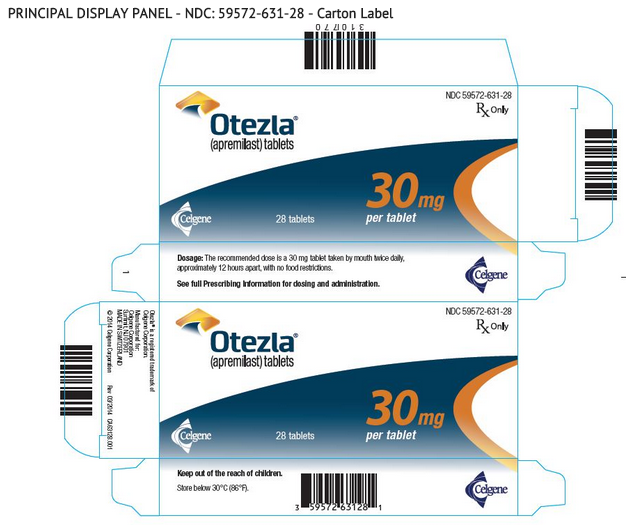
This image is provided by the National Library of Medicine. 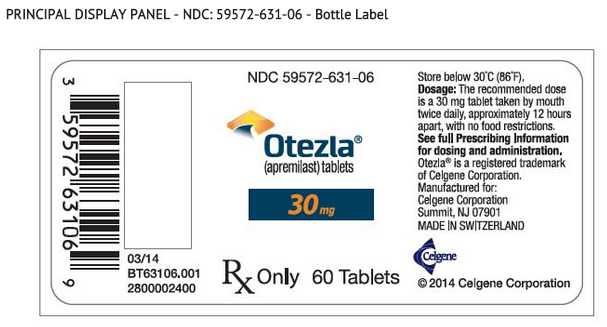
This image is provided by the National Library of Medicine.
Ingredients and Appearance
|fdaPatientInfo======Depression=====
- Before using OTEZLA in patients with a history of depression and/or suicidal thoughts or behavior, prescribers should carefully weigh the risks and benefits of treatment with OTEZLA in such patients. Patients, their caregivers, and families should be advised of the need to be alert for the emergence or worsening of depression, suicidal thoughts or other mood changes, and if such changes occur to contact their healthcare provider. Prescribers should carefully evaluate the risks and benefits of continuing treatment with OTEZLA if such events occur. [See Warnings and Precautions (5.1)].
Weight Decrease
- Patients treated with OTEZLA should have their weight monitored regularly. If unexplained or clinically significant weight loss occurs, weight loss should be evaluated, and discontinuation of OTEZLA should be considered [see Warnings and Precautions (5.2)].
Drug Interactions
- The use of strong cytochrome P450 enzyme inducers (e.g., rifampin, phenobarbital, carbamazepine, phenytoin) with OTEZLA is not recommended.
- Instruct patients to take OTEZLA only as prescribed.
- Advise patients OTEZLA can be taken with or without food.
- Advise patients that the tablets should not be crushed, split, or chewed.
- Advise patients about the side effects associated with OTEZLA
|alcohol=Alcohol-Apremilast interaction has not been established. Talk to your doctor about the effects of taking alcohol with this medication. |brandNames=* OTEZLA ®[2] }}
- ↑ 1.0 1.1 1.2 1.3 1.4 "Otezla (aprelimast) dosing, indications, interactions, adverse effects, and more". Medscape Reference. WebMD. Retrieved 28 March 2014.
- ↑ "Apremilast".

